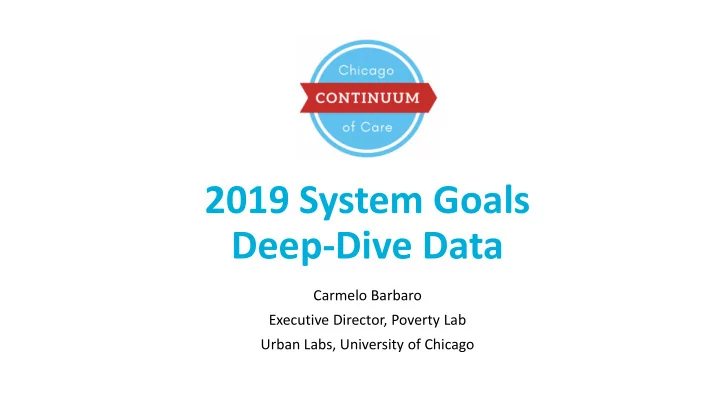

2019 System Goals Deep-Dive Data Carmelo Barbaro Executive Director, Poverty Lab Urban Labs, University of Chicago
Data Deep Dive System Goal 2: Reduce the time people remain homeless. System Goal 3: Homeless dedicated units should all be filled utilizing the Coordinated Entry System (CES).
S YSTEM M ONITORING & S TRATEGY I MPLEMENTATION D EVELOPMENT OF D ATA P RESENTATIONS P ROJECT L EAD TO B OARD OF & W ORK D IRECTORS G ROUP F EEDBACK
Background & Context 2018 2019 1,632 315 Housed Housed (first 3 months of year) 321 223 New Projected Units New Units
System Goal 2: Reduce the time people remain homeless. Metric 2.1: Average 90 days between entry into the homeless system and move into housing. Referral to Identified as Assessment Housing Housing Homeless Provider Metric 2.2: Average 30 days between referral to project and move into housing. Referral to Identified as Housing Assessment Housing Homeless Provider
Average Days to Housing: Jan 01, 2018 – March 31, 2019 ID to Housing Referral to Housing 250 205 200 194 180 170 159 150 Days 108 106 100 101 95 91 90 90 50 30 30 0 2018 Q1 2018 Q2 2018 Q3 2018 Q4 2019 Q1
Actual v. Goal ID to Referral Referral to Housing 120 120 108 106 101 97 95 93 100 100 91 75 74 80 80 68 60 60 60 60 60 Days Days 60 60 40 40 30 30 30 30 30 20 20 0 0 2018 Q1 2018 Q2 2018 Q3 2018 Q4 2019 Q1 2018 Q1 2018 Q2 2018 Q3 2018 Q4 2019 Q1 ID-Referral Goal ID-Ref Referral-House Goal Ref-Hse
Subpopulation Days to Housing ID to Referral Referral to House Total ID to House All 93 101 194 Chronically 112 96 208 Homeless Veteran 22 144 166 Youth 80 65 145 0 50 100 150 200 Days
System Goal 2: Reduce the time persons remain homeless. Key Points Next Steps 1. Progress made but slow 1. Lines of Work identify improvements o ID-to-Referral times varied more than Referral-to-Housing 2. Data monitoring & analysis continue 2. Resources led to quicker housing. o Youth – CE prioritization 3. Expand landlord engagement to be system wide o Vets – More dedicated resources 3. Process improvements also help 4. Skilled Assessors will improve the system o Youth – System Integration Team (SIT) 4. More housing resources are 5. CoC Board brings or realigns needed. resources
Data Deep Dive System Goal 3: Homeless-dedicated units should all be filled utilizing the Coordinated Entry System (CES). Metric 3.1: 100% of homeless-dedicated units will have been filled utilizing CES.
Units Filled Through Coord Entry versus Not Through Coord Entry Jan 01, 2018 –March 31, 2019 CES Referred Not CES Referred 2019 Q1 86% 14% 2018 Q4 80% 20% 2018 Q3 78% 22% 2018 Q2 79% 21% 2018 Q1 79% 21%
System Goal 3: Homeless dedicated units should all be filled utilizing the Coordinated Entry System (CES). Key Points Next Steps 1. Progress steady towards 1. SPEC & other work groups to meeting goal monitor non-compliance 2. Coordinated Entry engages 2. Continue training of providers agencies with monitoring and and new projects technical assistance. 3. Develop community- determined consequences to non-compliance.
Q&A
Recommend
More recommend